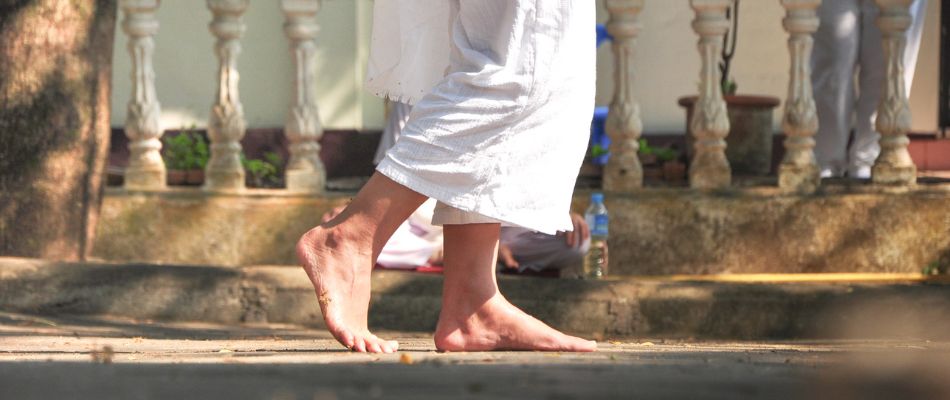With a surge of interest in meditation and its continued acceptance by nearly every type of person, the question still remains: Which is the style that each specific person should be doing? In our research on the top 17 styles of meditation, we we have found walking meditation to be unique for two main reasons: It can double or triple the time a person meditates each week thereby delivering more profound results and it teaches how to meditate during the events of our life rather than feeling good meditating on a cushion and trying to transfer that into the times that we need it the most.
Walking Meditation is a dynamic mindfulness practice that bridges the gap between physical movement and mental awareness. Practitioners us each step and breath to cultivate a deep connection to the present moment.
For those of you that have meditated for a while, you know that it takes a while to conjure up that oh-so-good-feeling you had during a meditation session the same way when you are frustrated, angry, in a difficult meeting, or even parenting a stubborn child. Meditation while walking gives us the chance to practice during an unstressful but continually changing activity so we know what to do when we need it the most.
But we’re just walking right? Yes and no. Sometimes the hardest thing to buy into is something that is extremely familiar to us. So, in this essay we’ll explore the historical origins, quickly “step” through the science behind the benefits, and then introduce walking meditations and two experts that have been sharing the these benefits for decades.

The History and Origins of Walking Meditation
When something like meditative walking seems too simple to be true, I find myself diving into the literature to see if I am caught up in a modern fad or if there is actually something behind it. Assuming it’s true, the next doubt that normally creeps in is a concern that in our continual effort to simplify everything (6-minute abs anyone?), we lose the process that got the original results. Walking meditation is actually pretty straight forward and has a rich history and that can be traced back to the early days of Buddhism.
Early Origins in Buddhism:
The practice of walking meditation has its roots in the Buddhist monastic tradition, where it was developed as a complement to seated practice (zazen). Monks and nuns would use walking meditation to break up long periods of sitting and to integrate mindfulness into their daily lives. This practice allowed them to maintain a meditative state even while engaged in ordinary activities.
Buddha’s Instructions:
The Buddha himself provided instructions for walking meditation as part of his teachings. In the “Maha-satipatthana Sutta” (The Great Discourse on the Foundations of Mindfulness), a pivotal text in early Buddhist literature, the Buddha outlined various forms of meditation, including walking. He emphasized the importance of being mindful in every aspect of one’s life, whether sitting, standing, lying down, or walking.
Zen Buddhism and Kinhin:
The practice of walking meditation evolved over time and took on different forms within various Buddhist traditions. In Zen Buddhism, it is known as “kinhin.” Kinhin is a slow, deliberate, and formal walking meditation practice that is often performed between periods of seated meditation. Zen practitioners walk in a prescribed pattern, usually in a circular path, while maintaining mindfulness of each step and breath. Kinhin is an integral part of Zen training, helping practitioners carry the meditative state into everyday activities.
Secular and Contemporary Adaptations of Walking Meditation:
In recent years, walking meditation has transcended its religious origins and has become a popular practice in secular mindfulness and wellness contexts. Mindfulness-based programs often incorporate walking meditation as a way to cultivate present-moment awareness, reduce stress, and enhance overall well-being. These secular adaptations maintain the essence of the practice while making it accessible to people of various backgrounds and beliefs.
It’s in this last phase that walking meditation crosses into Western territory and therefore is ripe for scientific scrutiny! This is actually a good thing. Scientific rigor not only proves the results, making us more likely to try it, but it gives us the steps to experience the same success, which we will cover next.

The 6 Top Researched Walking Meditation Benefits
Studies of walking meditation demonstrated the expected physical benefits of moving the body but additionally participants experienced improvements in mood, contentment, and mental health.
1. Stress Reduction
Walking meditation has been shown to reduce stress and promote relaxation.
A study published in the “Journal of Bodywork and Movement Therapies” by Liao et al. (2018) investigated the effects of meditating while walking on stress levels. The results demonstrated a significant reduction in stress among participants who practiced walking meditation regularly.
Reference: Liao et al., 2018 – Journal of Bodywork and Movement Therapies
2. Improved Attention and Concentration
Regular practice of walking meditation can enhance attention and concentration.
In a study published in the “Journal of Cognitive Enhancement,” Zanesco et al. (2016) examined the effects of a 10-day retreat, including meditating while walking, on attention and cognitive performance. The results indicated improvements in attention and working memory.
Reference: Zanesco et al., 2018 – Journal of Cognitive Enhancement
3. Mood Enhancement:
Walking meditation has been associated with improvements in mood and emotional well-being.
An investigation published in the “Journal of Alternative and Complementary Medicine” by Tomlinson et al. (2017) examined the effects of walking meditation on mood and psychological well-being. The findings showed positive changes in mood and increased feelings of well-being among participants.
Reference: Tomlinson et al., 2017 – Journal of Alternative and Complementary Medicine
4. Reduction in Symptoms of Anxiety and Depression
Walking meditation has been shown to be effective in reducing symptoms of anxiety and depression.
A study published in “Mindfulness” by Luberto et al. (2018) explored the impact of meditating while walking as an adjunct to standard treatment for individuals with major depressive disorder. The results indicated significant reductions in depressive symptoms.
Reference: Luberto et al., 2018 – Mindfulness
5. Enhanced Mindfulness and Awareness
Walking meditation cultivates mindfulness and present-moment awareness.
A study published in the “Journal of Behavioral Medicine” by Kiken et al. (2015) examined the effects of a 6-week walking meditation program on mindfulness and psychological well-being. The results demonstrated increased mindfulness and awareness.
Reference: Kiken et al., 2015 – Journal of Behavioral Medicine
6. Physical Health
Walking meditation can have physical benefits, including improved cardiovascular health and reduced muscle tension.
While many studies focus on the psychological benefits, it’s worth noting that the physical benefits of this practice are also recognized. Engaging with it regularly has been associated with improved cardiovascular health and reduced muscle tension, although specific studies on these physical effects may be less prevalent.
How To Do Walking Meditation – 6 Tips To Get The Most Out of the Practice
Now to the good part: this practice is simple. Weather permitting, it is the perfect excuse to get up from your desk and reset yourself. If you have the opportunity to get out in nature the experience is better but also serves as a great upgrade to your commute or way to take a break. Also, if you are new to meditation, it is easier that most other styles and a perfect way to get started.
While seated meditation often involves stillness and concentration on the breath or a mantra, walking meditation infuses mindfulness into a common motion. Whereas other meditations like tapping have a steeper learning curve, with this you just, well, walk while deepening your breath and concentrating on what is around you.
There really isn’t a suitable walking meditation script because you don’t necessarily need to do anything in a specific order. Here are six things to observe during your walk.
Have Slow and Deliberate Movements
Begin walking at a slower pace than usual, allowing each step to be deliberate and intentional. Feel the weight shift from one foot to the other.
Focus on Sensations in the Feet
Pay close attention to the sensations in your feet as they make contact with the ground. Notice the pressure, texture, and temperature.
Coordinate Breathing with Your Steps
Sync your breathing with your steps. For example, take one breath for every two or three steps. This synchrony deepens your mind-body connection.
Be Aware of Everything Around You
Expand your awareness to include the entire body as you walk. Feel the rhythm of your breath and the movement of your body as a harmonious whole.
Observe Surroundings with Your Senses
Hop through your senses noticing sights, sounds, smells, colors, and shapes.
Observe Thoughts and Emotions
Acknowledge any thoughts or emotions that arise during your practice. Instead of pushing them away, observe them with curiosity and gentleness.
Advanced Tip: The process described above is wonderful. If your mind wanders or you have something specific that is top of mind, you can walk and think on a specific intention or give gratitude. Intention and Gratitude: Walk with a specific intention or express gratitude with each step, infusing purpose into your practice.
Guided Walking Meditation
There are two teachers I would like to highlight that have made walking meditation part of their life’s work. Thich Nhat Hahn was a Buddhist monk who dedicated his life to peace and established a Buddhist center in France with a mission to increase the level of presence and peace in the world. Joe Dispenza has taken a more modern approach using it to unite people around the world through a simple process to create peace and connections.
Here are some very motivational videos that will definitely get you walking!
Thich Nhat Hanh Describes Walking Meditation
Thich Nhat Hanh Walking Meditation
Dr Joe Dispenza – Do This First Thing Each Day
Joe Dispenza Walking Meditation
Quickly Understand What Meditation is and Which to Choose
There are SO MANY ways to meditate! Whether you are brand new or expanding your practice, everyone benefits from learning about different available styles. There might be a style that better meets your needs or fits your personality. That’s why we wrote this essay on what meditation is and the 17 primary styles:
What is Meditation – The Primary Styles and Which to Choose
Then, we wrote articles on each of them!
| Body Scan Meditation | Chakra Meditation | Guided Meditation |
| Loving Kindness Meditation | Mantra Meditation | Sound Bath Meditation |
| Microcosmic Orbit Meditation | Qigong Meditation | Standing Meditation |
| Transcendental Meditation | Tapping Meditation | Zen Meditation |
| Vipassana Meditation | Insight Meditation | Walking Meditation |


